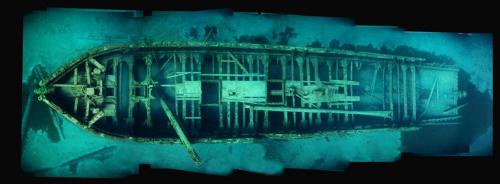Thunder Bay National Marine Sanctuary is a must-see for those interested in maritime heritage
Hundreds of shipwrecks, the cold and fresh water of Lake Huron help make Thunder Bay a top destination for divers.

This is the fourth story in a series about Great Lakes maritime history.
Visitors to the Thunder Bay National Marine Sanctuary near Alpena would be well advised to plan a full day or even two for their experience. Under the sponsorship of the National Oceanic and Atmospheric Administration and co-managed by the state of Michigan, the Sanctuary is located in northwestern Lake Huron and its 4,300 square miles contain hundreds of shipwrecks. The shallow waters of the Bay and the cold, fresh water of Lake Huron have preserved many of these wrecks in excellent condition, making the sanctuary a destination for divers from around the world.
But, even if you’re not a diver, there’s plenty to see and do during your visit. While many wrecks lie in deeper water, there are some that are easily accessible by kayak and even to snorkelers swimming from shore. Many of these are identified by marker buoys, including several less than ten feet below the surface.
If you like your history dry, there are glass bottomed boats that will take you directly over the wrecks on narrated tours. While the tours will not take you to every one of the 100 or so documented wrecks in the Sanctuary, you will be able to see a wide variety of the remains of ships, both sail and steam, dating from the mid-1800s to more recent wrecks from the past century.
To learn more, visitors are encouraged to visit the Great Lakes Maritime Heritage Center in Alpena. Located along the banks of the Thunder Bay River, it is a great place to learn not only about the shipwrecks, but also about the traders in fur, lumber, fish and limestone who operated those ships into the treacherous storms, and the accidents that claimed their vessels. A highlight of the Center is a reconstructed Great Lakes schooner that you can walk through as it rocks through a simulated stormy night on Lake Huron.
In addition to the schooner, the Center also includes a theater where films are shown daily, an archeology lab that demonstrates techniques of shipwreck preservation, and models of ships that have gone down in Thunder Bay and Lake Huron.
The Maritime Heritage Center also plays host to thousands of schoolchildren annually who come to learn about the Great Lakes thanks to a variety of programs offered throughout the year. Lesson plans are available for a wide range of topics, including a photomosaic activity that illustrates this fascinating technique for piecing together composite shipwreck images from many smaller images. The wreck of the E.B. Allen (shown) provides an excellent example.
There are also educator workshops to help teachers develop their Great Lakes and ocean literary. Both Michigan State University Extension and Michigan Sea Grant have used the Heritage Center facilities to host educational workshops and events. The current series of educator webinars includes a March offering on how to build your own underwater remotely operated vehicle (ROV).
While winter weather will bring a halt to the glass bottomed boats and all but the most intrepid divers, the Maritime Heritage Center remains open throughout the year and admission is free. For more information and to plan your visit, go to www.thunderbay.noaa.gov.
After your visit to the Thunder Bay National Marine Sanctuary, you can learn more about shipwrecks and our other maritime heritage resources by coming aboard for some of the Summer Discovery Cruises offered on both Lake St. Clair and Lake Erie each year. Sponsored by Michigan State University Extension, Michigan Sea Grant, and the Huron-Clinton Metroparks, Summer Discovery Cruises are a fun way to learn about our many historical, cultural, and natural Great Lakes resources.
Michigan Sea Grant helps to foster economic growth and protect Michigan’s coastal, Great Lakes resources through education, research and outreach. A collaborative effort of the University of Michigan and Michigan State University and its MSU Extension, Michigan Sea Grant is part of the NOAA-National Sea Grant network of 33 university-based programs.
Read the full series:
Part 1: Detroit’s Dossin Great Lakes Museum
Part 2: Michigan’s underwater preserves
Part 3: National Museum of the Great Lakes
Part 4: Thunder Bay National Marine Sanctuary
Part 5: Great Lakes Shipwreck Museum



 Print
Print Email
Email


